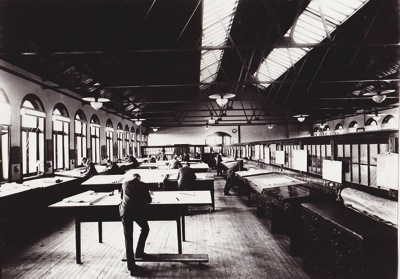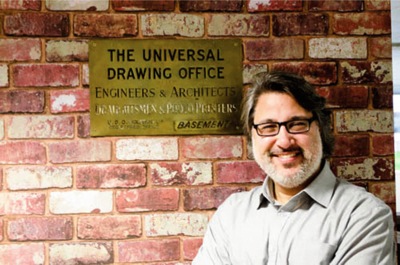Managing director Michael Barton-Harvey
Much has changed in the century during which the Universal Drawing Office has become Service Point.
The original copper nameplate that was mounted outside Service Point’s first production facility turned up at the back of a cupboard at its headquarters building in recent times. The nameplate has been polished and mounted into a wall at the new Farringdon Road site. Proudly, it announces: The Universal Drawing Office, 1914, Engineers & Architects, Draughtsmen and Photo Printers.
Since the original UDO site was situated in Bowling Green Lane, EC1, this means that in 100 years, the organisation seems to have moved perhaps a little less than 500 metres. In fact, it has been rather more mobile: Service Point now has almost 100 sites around the world in eight territories, plus 400 sites embedded within its customers’ facilities.
As the war clouds gathered in 1914 though, UDO was setting out to offer hand drawing services to technical customers. Reprography and lithography services followed. It even had its own paper mill. Referring to the ‘Universal’ aspect of the original name, current UK managing director Michael Barton-Harvey jokes: ‘It was never enough for us to be global – even in 1914 we wanted the Universe.’ He explained how the company developed:
‘They became so busy 100 years ago that they had to try and automate. We do that now, but they realised that even then – it meant removing human beings from the process. By the 1960s, companies started saying: ‘we want you to be part of our operation internally’. We have always been renowned for producing highly secure documents.
 The original Universal Drawing Office
The original Universal Drawing Office
‘The company has grown through acquisition – 23 companies across the UK over the course of 40 years. What UDO did in the 1960s was aligned themselves with groups around the UK, and very quickly built a distributed network. We were producing documents close to the point of need.’ In 1998, UDO was approached by a company from Spain called Grupo Picking Pack, which had 400 locations in Europe, and wanted a network in the UK to sell office products. UDO had 60 locations at that point.
‘It was the first time in history that a Spanish Plc bought a UK Plc,’ Mr Barton Harvey continued. ‘They did business services but not a lot of print and repro. During the course of this process, it became apparent that actually print and repro would be the future of their operations, and their sites became document centres across Europe. They decided to call every site a Picking Pack Service Point and that’s where the brand came from.’
In some ways, little has changed in a century. As UDO did, Service Point still produces technical documents for customers. These days though, there are banks of wide format plotters whirring quietly away, rather than banks of draughtsmen, heads bent over their drawings.
There really is a great deal more going on as well in 2013, though. Service Point operates in three main areas: Business services – helping customers to get all their information synchronised at a single point; Print and media; and Online and store, which includes web to print software and things such as office supplies.
Put most simply, the organisation is about documents, printed or electronic, and the ownership of the content that goes into them. Having the content enables Service Point to re-use and reversion information for multiple channels, making it a cross media operator too. ‘We see ourselves as a media-based content management company,’ Mr Barton-Harvey stated.
One of the biggest growth areas, ironically, is scanning. Customers, who are among the world’s largest companies, want everything in a central system, enabling them to synchronise their document creation, and deal with print in a very different way. But while they may want their information centralised, they also want a supplier that can provide a local service globally, sometimes even from within their own organisations.
This is where Service Point’s network is a distinct advantage. He continued: ‘We are a local service, we want to be convenient. These days, people want you to be part of their network. We want to be hyper-local.’
The organisation is creating radically different approaches for different markets. Architects, marketers, people that want photo services, books on demand (Service Point claims to be the second largest photobook producer in Europe), financial services documents – all of these have specific requirements that the company is catering for, and they need to be addressed in a specific language and style.
‘It’s not about the document; it’s about the end use. This is where the last 10 years of evolution has taken us: it became very interesting for us to say to customers: what do you actually want to achieve with this document? It might be to grow business, or achieve brand consistency; many different things. We don’t get asked about print and documents; we get asked: how can we engage two million people to achieve something?’ The management of large organisations’ documents, either virtual or physical, in an orchestrated way, means that Service Point can introduce massive economies of scale.
Software developed by the company’s own R&D team adds more efficiency and automation to the process. Of the UK operation’s near 600 employees, two thirds are dedicated to production, and the rest to the customers. ‘Get the production base and operations correct, and you will deliver what you say you will deliver,’ observed Mr Barton-Harvey.
To mark its 100th birthday, Service Point has a few plans up its sleeve: on the one hand, some high tech wizardry; on the other, some altruistic generosity. A new home-grown generation of software systems to be launched will make it easier for customers to interact with and manage their documents and information, giving them massive control and potential to automate through the cloud.
It is planning to set up a foundation in all its UK regions, through which it will donate a large amount of print to help local organisations to promote their services. Also, due to a programme of investment in smaller printing machines, the company has space to spare, which it will offer for free to local companies involved in media, content, and the creative world. ‘We want great local people that want to build their businesses, and we will give them an environment where they can do that,’ he commented.
Almost a century down the line from the day that the copper nameplate was first nailed up, what does Service Point stand for? ‘We have always acted as a safety net for people with very demanding deadlines. We have always said, do what you do best, we will worry about the deadline,’ Mr Barton-Harvey responded. ‘And we have always been about creating things closer to the point of need. The name Service Point came about through offering service at the point of need. The most compelling thing we are giving clients is choice and convenience. That’s what people want now.’






Hi, can you tell me if this the UDO group that had repro and photographic service brances.
ie.. Abbey studio’s, Bloomsbury, grays in road, North Audely street, Villiers street, Stratford, Autolith Lambs conduit street etc?
Hi John, this one is well before the current editorial team’s tenure, can anyone else help?
Hi, I worked for UDO in Bowling Green Lane from 1988 to 1994, the branches you mention were UDO sites and I believe Service Point is the old UDO. Hope this helps. Lissa